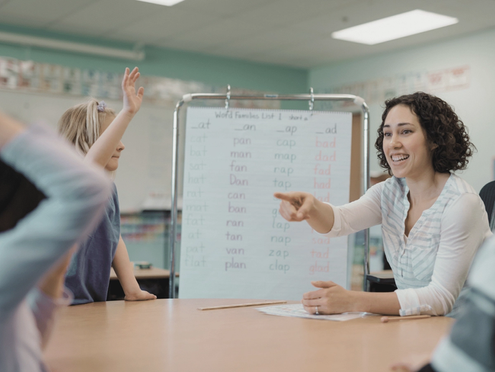What is pre-teaching?
Pre-teaching is a strategy that involves teaching learners about concepts or skills before they encounter them in the classroom. This technique aims to provide the language and skill building blocks to ensure every learner is prepared for new concepts before the next topic takes place. Pre-teaching differs from other types of self-led learning, as the subject matter will always be explored in the subsequent lesson. This reserves the classroom for the application or deepening of knowledge rather than the introduction of it.
The primary objective of pre-teaching is to establish the foundations for a single lesson or unit of work. This helps to identify the gaps in knowledge for your learners before its application, and bridging this gap ensures the upcoming lessons will be successful for both them and the teachers involved.
Often pre-teaching is approached through flipped learning, in which lesson content is given to learners as homework to allow them to prepare for the upcoming lesson. This allows the classroom to be a space where ideas are discussed and explored. Vocabulary is understood in advance through set videos or word lists.
Flipped learning can be an engaging way for older learners to explore terms outside of the classroom: you can set research tasks about broader topics and prepare them for a deeper discussion during the next lesson.
Alternatively, pre-teaching can be done in the classroom. On a Friday you could preview the upcoming topics for the next week and provide any essential knowledge and vocabulary for them to practise. This can be provided through a list of new words, some of the history behind a topic, or revising previously learned skills which are necessary for upcoming tasks.
How does pre-teaching vocabulary work?
Limited vocabulary is one of the biggest obstacles to learners’ writing and reading comprehension. A lack of varied and academic vocabulary directly affects a learner’s ability to understand a subject and, as a result, they can begin to fall behind their peers in the classroom. Pre-teaching provides learners with an understanding of concepts before they are discussed in the classroom and, as they learn more vocabulary, they will become more fluent. Rather than stopping to figure out words as they read, they will begin to recognise terms and understand contexts when encountering new ones.
Pre-teaching often employs vocabulary lists to help learners prepare for any upcoming new words. Learners can spend time understanding their meaning before the class begins. This encourages greater comprehension of a text as they face fewer unfamiliar words and experience a lower cognitive load when reading. Pre-teaching is also a method of scaffolding, as it creates a structure of support for learners when they first experience new vocabulary.
It is important to note that these vocabulary lists are not exclusive to English classes: pre-learning can be used for any subject which uses subject-specific language. For example, if you are introducing a new topic in a maths lesson, Tier 3 words such as “radius” and “circumference” should be included in a pre-teaching vocabulary list to ensure every learner is prepared and able to fully engage in the lesson.
Why is pre-teaching vocabulary important?
Pre-teaching allows prior knowledge to be revised before the content is explored within the classroom, and the more prior knowledge a learner has, the better equipped they will be to understand its application in subject-specific settings. It also provides an alternative to homework and testing: rather than giving learners homework after the lesson, you could ask them to research in advance for a new topic online or by watching a specific video.
Pre-teaching allows learners to improve their reading comprehension too. For lessons such as English, learners can read a chapter or a text in advance at home. This makes the classroom a space for the analysis of a book rather than simply reading it. As reading comprehension is an essential skill for learners, this use of pre-teaching ensures each of them receives the maximum amount of time when analysing and understanding texts.
This means learners become less intimidated by unfamiliar words they encounter in the classroom. Instead of having to put their hand up in the classroom and ask what certain terms mean, they can first encounter them in a place where they feel most comfortable: younger learners can ask a parent or guardian for definitions, and older learners can look them up online.
Vocabulary lists can be used to introduce academic definitions for everyday words. There are many concepts that learners will have encountered outside of the classroom that they have been unable to describe. Providing essential and varied vocabulary ensures every learner has the building blocks necessary to both describe the world around them and succeed within the classroom.
Pre-teaching has been seen to improve overall academic achievement. Learners are given space to explore essential language and vocabulary outside of school, and this means they can understand the language used within the classroom before it is introduced. This allows learners to make accelerated progress when encountering new concepts. Many learners, when returning to school, will begin to feel more in control, and this confidence allows them to be more actively involved in their learning.
Are there challenges to pre-teaching?
Although there are many benefits to pre-teaching, you may encounter some challenges when implementing it in the classroom.
Pre-learning can be time-consuming for both teachers and learners: teachers could spend a significant amount of time providing vocabulary lists or tasks for learners to complete at home, and this leads to learners spending much more time doing homework. Some learners may find it difficult to complete this amount of work at home, which could lead to these learners falling behind.
To implement pre-teaching, ensure that lessons are balanced so that only the essential vocabulary or reading is done at home, and every learner returns to school with the same preparation. This can be simplified for both teacher and learner by utilising Bedrock Mapper's pre-made vocabulary resources.
Additionally, some teachers may find themselves introducing unnecessary words when setting up pre-teaching work. This can become confusing for some learners, as they can become unsure about when to use certain words within the classroom. Additionally, some learners could begin to forget some of the less relevant terms if they are not scaffolded within the classroom. To ensure these words are memorised, only include the most important words in a vocabulary list, and scaffold them through in-person teaching.
It is important to remember that some learners may struggle with the new terms when learning them out of context. For example, if you include subject-specific words such as “radius” before you have explored the application of the word in the classroom, learners can become confused. Any pre-teaching vocabulary solution should embed definitions of new terminology in relevant applications, linking it to prior knowledge - Mapper's vocabulary instruction links definitions to examples, formulae and image activities to reinforce this.
What does pre-teaching look like inside the classroom?
When introducing pre-teaching in the classroom, it is crucial to identify any essential words your learners will need to understand a topic. Words such as “subtraction” or “tempo” are essential for maths or music, so learners will need to understand them to excel in the classroom.
Tiered vocabulary is also beneficial for learners when exploring new subjects. Tier 1 words are everyday words which learners are likely to hear outside of the classroom. However, Tier 2 words, which are more complex, and Tier 3 words, which are subject-specific, are less likely to be spoken aloud. This means it is important to select relevant words when planning lessons, as these more words can help comprehension skills across all subjects, not just the text being analysed in the classroom. Tier 1 words play a role in enveloping new Tier 2 and 3 vocabulary, making it accessible for learners to comprehend more ambitious terminology.
There are also many methods of putting pre-teaching into practice. You could introduce vocabulary lists so learners can discover definitions and meanings outside of class. In addition to this, you could use visual representations to help learners conceptualise vocabulary that they have not yet encountered; many learners find reading more engaging if there are images alongside the text.
Alternatively, you can read out new vocabulary to your learners and ask them to repeat the words back to you. Some learners can be nervous about using new words, especially if they do not know how to pronounce them, so this repetition in the classroom encourages them to use more varied language out loud as well as in their writing. This can also be completed at home, with your learners practising pronouncing new vocabulary with their parents - or, after a bit of practice, using new terminology in a sentence.
How can Bedrock support pre-teaching in your classroom?
To reap the benefits of pre-teaching, teachers across the curriculum should have a consistent, explicit vocabulary curriculum. For a time-poor teacher, fitting this strategy amongst a content-heavy lesson plan can be difficult and time consuming.
To support teachers in facilitating pre-teaching, Mapper’s new sequencing algorithm allows teachers to plan and sequence their bespoke vocabulary curriculum quickly and easily. Teachers in every subject can draw from a wealth of Bedrock-created content, optimised to multiple exam boards, in order to combine a digital Tier 3 vocabulary curriculum with success in the classroom.
Sequenced correctly - and Mapper’s algorithm makes this simple to achieve - learners are pre-taught the subject-specific Tier 2 and Tier 3 vocabulary they need for each topic before the lesson starts, ensuring they enter the classroom enriched with the necessary prior knowledge.




